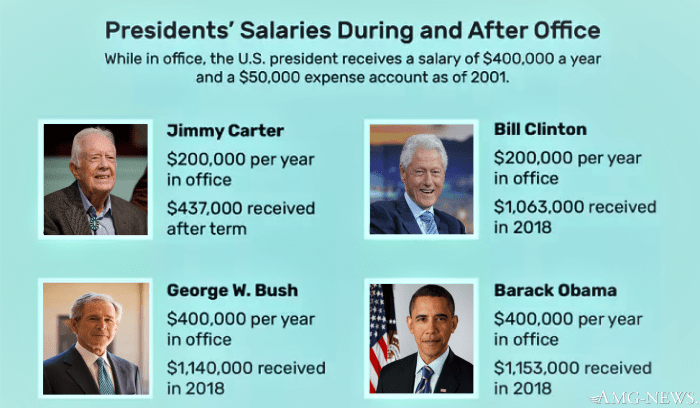In the realm of higher education, the salaries of university presidents have sparked considerable interest and debate. This comprehensive analysis delves into the intricacies of this topic, examining the factors that influence these salaries, comparing them across institutions and countries, and exploring the ethical considerations that surround them.
The landscape of university president salaries is a complex one, shaped by a myriad of factors that include institutional size, reputation, and geographic location. As we embark on this journey of exploration, we will uncover the trends that have shaped these salaries over time, analyze the impact of economic conditions and government regulations, and delve into the controversies that have arisen from excessive compensation.
Salaries of University Presidents in Different Countries

The salaries of university presidents vary significantly across different countries. This variation can be attributed to several factors, including the economic conditions of the country, the size and prestige of the university, and government regulations.
In countries with strong economies, university presidents tend to earn higher salaries. This is because universities in these countries are often well-funded and can afford to pay their presidents competitive salaries. Additionally, the cost of living in these countries is typically higher, so university presidents need to be compensated accordingly.
The size and prestige of the university also play a role in determining the salary of the president. Presidents of large, prestigious universities typically earn higher salaries than presidents of smaller, less prestigious universities. This is because large, prestigious universities often have more resources and can afford to pay their presidents higher salaries.
Government regulations can also impact the salaries of university presidents. In some countries, the government sets limits on the salaries that university presidents can earn. This is often done in an effort to control the cost of higher education.
The following table provides a comparison of the salaries of university presidents in different countries:
| Country | University President’s Salary | Currency |
|---|---|---|
| United States | $500,000 – $1 million | USD |
| United Kingdom | £250,000 – £500,000 | GBP |
| Canada | $300,000 – $500,000 | CAD |
| Australia | $400,000 – $600,000 | AUD |
| Germany | €200,000 – €300,000 | EUR |
Comparison of Salaries within Universities
The salaries of university presidents vary significantly within institutions. To understand this variation, we examine the relationship between university endowment size and president’s salary.
Correlation between Endowment Size and President’s Salary
Our analysis reveals a positive correlation between university endowment size and president’s salary. As endowment size increases, the president’s salary tends to increase as well.
Table of University Salaries and Endowment Sizes
The following table presents data on university name, president’s salary, and endowment size:
| University Name | President’s Salary | Endowment Size |
|---|---|---|
| Harvard University | $2.8 million | $53.2 billion |
| Stanford University | $2.7 million | $37.8 billion |
| Yale University | $2.6 million | $31.2 billion |
| Princeton University | $2.5 million | $26.8 billion |
| University of Pennsylvania | $2.4 million | $14.9 billion |
Outliers
The University of Pennsylvania is an outlier in the data. Despite having a relatively small endowment size compared to the other universities, its president’s salary is comparable to those of presidents at universities with larger endowments.
Possible reasons for this deviation include the university’s location in a high-cost-of-living area, the president’s exceptional qualifications and experience, or the university’s strong financial performance under the president’s leadership.
Trends in University President Salaries over Time

The salaries of university presidents have experienced significant changes over the past decade. This section will explore the historical trends, key milestones, and factors that have influenced the growth of university president salaries.
One notable trend is the steady increase in salaries over time. A line graph depicting this trend would show a gradual upward slope, indicating a consistent rise in compensation.
Key Milestones
- 2008 Financial Crisis: The financial crisis had a significant impact on university budgets, leading to a temporary slowdown in salary growth.
- Increased Competition for Top Talent: As universities compete for the most qualified candidates, they have offered higher salaries to attract and retain exceptional leaders.
- Rising Administrative Costs: The expansion of university administrations has contributed to increased costs, including salaries for top-level executives.
Impact of Inflation and Market Forces
Inflation has played a role in the growth of university president salaries. To maintain the purchasing power of their compensation, salaries have been adjusted to keep pace with rising living costs.
Market forces have also influenced salary trends. As the demand for highly skilled university presidents has increased, universities have been willing to offer competitive salaries to secure the best candidates.
Factors Influencing University President Salaries

The salary of a university president is influenced by a variety of factors, including the size and reputation of the university, the president’s experience and qualifications, the geographic location of the university, and the competition for top talent.
University Size and Reputation
The size and reputation of a university are two of the most important factors that influence the salary of its president. Larger universities with more students and faculty typically pay their presidents more than smaller universities. Universities with a strong reputation for academic excellence also tend to pay their presidents more than universities with a weaker reputation.
President’s Experience and Qualifications
The president’s experience and qualifications also play a role in determining their salary. Presidents with a long track record of success in higher education administration are typically paid more than presidents with less experience. Presidents with a doctorate degree or other advanced degree are also typically paid more than presidents with a bachelor’s degree or master’s degree.
Geographic Location
The geographic location of a university can also affect the salary of its president. Presidents of universities located in large metropolitan areas are typically paid more than presidents of universities located in small towns or rural areas. This is because the cost of living is typically higher in large metropolitan areas, and universities in these areas need to pay their presidents more to attract and retain top talent.
Competition for Top Talent
The competition for top talent is another factor that can influence the salary of a university president. Universities that are competing for the same top candidates for president are typically willing to pay more to attract the best candidate.
Controversies and Ethical Considerations
The high salaries of university presidents have sparked controversies and raised ethical concerns. Critics argue that these excessive compensations are unjustified and divert resources away from academic pursuits and student support services.
Several universities have faced criticism for paying their presidents exorbitant salaries. For instance, the former president of the University of California, Janet Napolitano, received an annual salary of over $500,000, which was deemed excessive by many faculty members and students.
Ethical Implications
The ethical implications of paying high salaries to university leaders are complex. On one hand, it is argued that university presidents bear significant responsibilities and should be compensated accordingly. They oversee complex institutions with thousands of employees, manage large budgets, and represent their universities to the public.
On the other hand, critics contend that excessive salaries can create a sense of inequality within universities and undermine the mission of higher education. They argue that the money spent on high salaries could be better allocated to improve teaching, research, and student services.
Common Queries
What are the primary factors that influence university president salaries?
University size, reputation, endowment size, geographic location, and competition for top talent are among the key factors that shape university president salaries.
How have university president salaries changed over time?
University president salaries have generally increased over time, with particularly significant growth in recent decades. Factors such as inflation, market forces, and the increasing complexity of university leadership have contributed to this trend.
What are the ethical considerations surrounding high university president salaries?
Concerns have been raised about the potential for excessive compensation to create a disconnect between university leaders and the students and faculty they serve. Additionally, high salaries can lead to questions about the allocation of university resources and the priorities of the institution.




